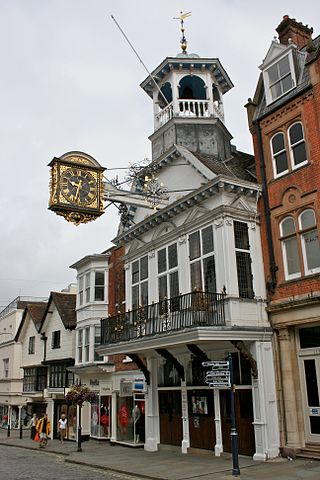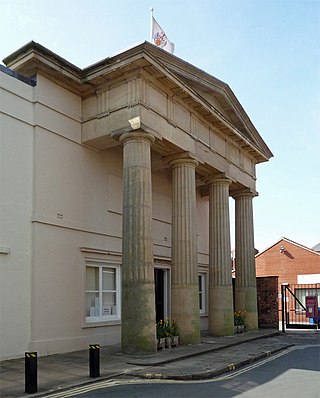
Much Wenlock is a market town and parish in Shropshire, England; it is situated on the A458 road between Shrewsbury and Bridgnorth. Nearby, to the north-east, is the Ironbridge Gorge and Telford. The civil parish includes the villages of Homer, Wyke, Atterley, Stretton Westwood and Bourton. The population of the civil parish, according to the 2001 Census, was 2,605, increasing to 2,877 by 2011.

The Wenlock Olympian Games, dating from 1850, are a forerunner of the modern Olympic Games. They are organised by the Wenlock Olympian Society (WOS), and are held each year at venues across Shropshire, England, centred on the market town of Much Wenlock. One of the two mascots for the 2012 Summer Olympics was named Wenlock in honour of the Wenlock Olympian Games.

Little Wenlock is a village and civil parish in the Telford and Wrekin borough in Shropshire, England. The population of the civil parish at the 2011 census was 605. It was mentioned in the Domesday Book, when it belonged to Wenlock Priory. Ancient habitation is attested by the discovery of two caches of Bronze Age weapons. The village is situated two miles west of Dawley.

William Penny Brookes was an English surgeon, magistrate, botanist, and educationalist especially known for founding the Wenlock Olympian Games, inspiring the modern Olympic Games, and for his promotion of physical education and personal betterment.

The Guildford Guildhall is a Guildhall located on the High Street of the town of Guildford, Surrey. It is a Grade I listed building.
Shit Brook is a culverted small stream in Much Wenlock, Shropshire, England.
William Brookes School is a mixed secondary school and sixth form located in Much Wenlock in the English county of Shropshire. The school is named after William Penny Brookes, a surgeon, magistrate, botanist, and educationalist from Much Wenlock especially known for inspiring the modern Olympic Games with the Wenlock Olympian Games. The school serves a community of small villages as well as the larger town of Broseley.

Weymouth Guildhall is a former guildhall at Weymouth, Dorset, England. The building, which was constructed in the 1830s, is a Grade II* listed building.

The Guildhall is a municipal facility at Register Square in Beverley, East Riding of Yorkshire, England. It is a Grade I listed building.

The Old Shirehall was a municipal facility in Market Square, Shrewsbury, Shropshire. It was demolished in 1971 to make way for a retail and commercial centre.

Stratford-upon-Avon Town Hall is a municipal building in Sheep Street, Stratford-upon-Avon, Warwickshire. It is a Grade II* listed building.

Bridgnorth Town Hall is a municipal building in the High Street, Bridgnorth, Shropshire, England. The town hall, which is a meeting place of Bridgnorth Town Council, is a Grade II* listed building.

Evesham Town Hall is a municipal structure in the Market Place in Evesham, Worcestershire, England. The town hall, which was the headquarters of Evesham Borough Council, is a Grade II listed building.

Oswestry Guildhall is a municipal building in Bailey Head in Oswestry, Shropshire, England. The structure, which was the meeting place of Oswestry Municipal Borough Council, is a Grade II listed building.

Helston Guildhall, formerly Helston Town Hall, is a municipal building on Market Place, Helston, Cornwall, England. The structure, which is the meeting place of Helston Town Council, is a Grade II* listed building.

The Guildhall is a municipal building in Fore Street in Plympton, Devon, England. The structure, which is used as a community events venue, is a Grade II* listed building.

Holy Trinity Church in Much Wenlock, Shropshire, England. Located on Wilmore Street and dating to the early 12th century, it is now a Grade I listed building.

Bishop's Castle Town Hall is a municipal building in the High Street in Bishop's Castle, Shropshire, England. The building, which is the meeting place of Bishop's Castle Town Council, is a Grade II* listed building.

The Corn Exchange is a commercial building in the High Street in Much Wenlock, Shropshire, England. The structure, which is currently used as a library, is a Grade II listed building.

The Old Guildhall is a municipal building in Higher Market Street in Looe, Cornwall, England. The structure, which is currently used as a museum, is a Grade II* listed building.




















